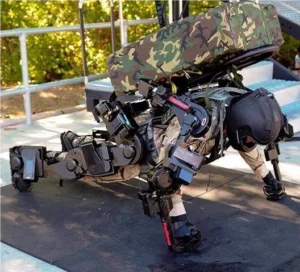
Why is the Indian Army’s Tech Odyssey in the news?
- In an era characterized by rapid technological advancement and evolving warfare dynamics, the Indian Army has embarked on a transformative journey, heralding the ‘Year of Technology Absorption’ in 2024.
- This pivotal initiative underscores the Army’s commitment to embracing disruptive technologies (DTs) under the overarching theme of Atmanirbharta (self-reliance). This blog delves into the multifaceted dimensions of this technological odyssey, exploring its implications, challenges, and the imperative for indigenous innovation.
The Essence of Disruptive Technologies:
- Disruptive technologies represent a paradigm shift in warfare, reshaping traditional practices and augmenting military capabilities.
- From artificial intelligence (AI) to unmanned aerial vehicles (UAVs) and hypersonic weapons, these innovations hold the promise of revolutionizing military strategies and operations.
- The Indian Army’s focus on DTs underscores the recognition of their game-changing impact, rapid advancement, and cost-efficiency in enhancing national security.
Atmanirbhar Bharat: A Catalyst for Technological Sovereignty:
- Atmanirbhar Bharat, or self-reliant India, lies at the heart of India’s quest for technological sovereignty in the defense sector.
- Despite notable achievements in indigenous defense production, significant reliance on imports persists, posing strategic vulnerabilities.
- The Defence Acquisition Procedure (DAP) 2020, with its emphasis on indigenous content and Make in India initiatives, seeks to redress this imbalance by fostering indigenous innovation, production, and collaboration.
Challenges on the Technological Horizon:
- The pursuit of technological absorption is not without its challenges.
- India’s relatively low R&D expenditure, coupled with limited industry-academia linkages, impedes indigenous innovation and technology development.
- Licensing issues, cybersecurity vulnerabilities, and concerns over technological obsolescence further underscore the complexities inherent in technology absorption.
- Addressing these challenges necessitates a multifaceted approach, encompassing strategic investment, policy reforms, and international collaboration.
Strategic Imperatives and Operational Realities:
- While disruptive technologies offer unprecedented opportunities for military modernization, their strategic relevance must be contextualized within operational realities.
- Enhanced situational awareness, precision targeting, and asymmetric warfare capabilities are among the tangible benefits conferred by DTs.
- However, the efficacy of these technologies in shaping conflict outcomes remains contingent upon a myriad of factors, including doctrinal adaptation, interoperability, and human capital.
Conclusion: Navigating the Path Ahead
- As the Indian Army embarks on its technological odyssey, the imperative for Atmanirbharta in defense assumes paramount significance.
- By harnessing disruptive technologies, fostering indigenous innovation, and addressing systemic challenges, India can bolster its technological sovereignty and strategic resilience in an era of unprecedented uncertainty.
- The journey towards self-reliance is fraught with complexities, yet it is also replete with opportunities to shape the future contours of national security.
- In navigating the path ahead, the Indian Army stands poised to embrace the technological frontiers of the 21st century, safeguarding the nation’s interests and aspirations on the global stage.
People also ask
Q1: What is the significance of the Indian Army observing 2024 as the ‘Year of Technology Absorption’?
Ans: The Indian Army’s designation of 2024 as the ‘Year of Technology Absorption’ underscores its commitment to embracing disruptive technologies (DTs) to stay ahead of adversaries amidst evolving warfare dynamics.
Q2: What is the overarching theme guiding the Indian Army’s technological transformation?
Ans: The overarching theme guiding the Indian Army’s technological transformation is Atmanirbharta, which emphasizes self-reliance and indigenous innovation in defense.
Q3: What are some examples of disruptive technologies being pursued by the Indian Army?
Ans: Examples of disruptive technologies being pursued include artificial intelligence (AI), autonomous weapon systems such as drones, sensors, robotics, space technology, and hypersonic weapon systems.
Q4: How does the adoption of disruptive technologies impact military operations?
Ans: Disruptive technologies enhance situational awareness, precision and lethality, and enable asymmetric warfare tactics, thereby augmenting the Indian Army’s operational capabilities and effectiveness.
Q5: What initiatives has India undertaken to promote indigenous defense production?
Ans: India has implemented initiatives such as the Defence Acquisition Procedure (DAP) 2020, which mandates a certain percentage of indigenous content in procurement contracts and prioritizes ‘Make in India’ endeavors.
Can you be more specific about the content of your article? After reading it, I still have some doubts. Hope you can help me.
Thank you for your sharing. I am worried that I lack creative ideas. It is your article that makes me full of hope. Thank you. But, I have a question, can you help me?
I don’t think the title of your article matches the content lol. Just kidding, mainly because I had some doubts after reading the article. https://accounts.binance.com/kz/register-person?ref=RQUR4BEO